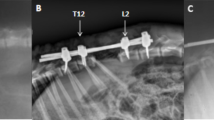Abstract
Spinal shortening is performed for a wide spectrum of diseases. This study was designed to investigate the morphologic effects of shortening on the spinal cord, to enlighten the amount and direction of the sliding of the cord, the alteration of the angles of the roots, and to identify the appropriate laminectomy length. Total vertebrectomy of T12 was applied to ten sheep models after spinal instrumentation. Gradual shortening was applied to five sheep; then, the degree and direction of the sliding of the spinal cord and the angles of the adjacent roots were measured. On five other sheep, additional sagittal sectioning was performed via excision of the pedicles. Measurements were taken at different laminectomy lengths to record kinking of the spinal cord with gradual shortening. The mean sliding of the spinal cord was 9 mm cranially and 7.8 mm caudally. T11 spinal nerves became more vertical caudally, and T12 spinal nerves achieved an ascending position with gradual shortening. Both T11 and T12 spinal nerves were sharply bent in the foramen and on the pedicle of T13, respectively. In full-length shortening, the mean kink of the spine in the sagittal plane was 92.4° for two levels of hemi-laminectomies, 24.6° for complete laminectomy of T11 with hemilaminectomy of T13, and 20.2° for two levels of complete laminectomies. The slippage of the cord is dominant in the earlier stages and kinking is dominant in later stages of shortening. Increasing the laminectomy length by only a half or one level prevents excessive kinking and compressions at the upper and lower margins of the laminectomy. In the later stages of shortening, the spinal nerves near the vertebrectomy site are at risk because of the sharp bending of the nerves. This study describes the mechanism of the sliding and kinking of the cord due to gradual shortening of the spine, which might be useful in spinal surgery procedures. It also states that it is possible to avoid excessive kinking by planning the appropriate technique of laminectomy style in full-length shortening.


Similar content being viewed by others
References
Bridwell KH, Lewis SJ, Rinella A, Lenke LG, Baldus C, Blanke K (2004) Pedicle subtraction osteotomy for the treatment of fixed sagittal imbalance. Surgical technique. J Bone Joint Surg (Am) 86-A:44–49
Carlson GD, Gorden CD, Oliff HS, Pillai JJ, LaManna JC (2003) Sustained spinal cord compression. Part I. Time-dependent effect on long-term pathophysiology. J Bone Joint Surg (Am) 85-A:86–94
Grunenwald D, Mazel C, Girard P, Berthiot G, Dromer C, Baldeyrou P (1996) Total vertebrectomy for en-bloc resection of lung cancer invading the spine. Ann Thorac Surg 61:723–726
Heary RF, Vaccaro AR, Benevenia J, Cotler JM (1998) “En-bloc” vertebrectomy in the mobile lumbar spine. Surg Neurol 50:548–556
Kawahara N, Tomita K, Fujita T, Maruo S, Otsuka S, Kinoshita G (1997) Osteosarcoma of the thoracolumbar spine: total en bloc spondylectomy. A case report. J Bone Joint Surg (Am) 79-A:453–458
Kawahara N, Tomita K, Baba H, Kobayashi T, Fujita T, Murakami H (2001) Closing-opening wedge osteotomy to correct angular kyphotic deformity by a single posterior approach. Spine 26:391–402
Kawahara N, Tomita K, Kobayashi T, Abdel-Wanis ME, Murakami H, Akamaru T (2005) Influence of acute shortening on the spinal cord: an experimental study. Spine 30:613–620
Lazar RD, Hall JE (1999) Simultaneous anterior and posterior hemivertebra excision. Clin Orthop Rel Res 364:76–84
Magerl F, Costia MF (1998) Total posterior vertebrectomy of the thoracic or lumbar spine. Clin Orthop Rel Res 232:62–69
Nakamura H, Matsuda H, Konishi S, Yamano Y (2002) Single stage excision of hemivertebrae via the posterior approach alone for congenital spine deformity. Spine 27:110–115
Potter BK, Lenke LG, Kuklo TR (2004) Prevention and management of iatrogenic flatback deformity. J Bone Joint Surg (Am) 86:1793–1808
Ruf M, Harms J (2003) Posterior hemivertebra resection with transpedicular instrumentation: early correction in children aged 1 to 6 years. Spine 28:2132–2138
Ruf M, Jensen R, Harms J (2005) Hemivertebra resection in the cervical spine. Spine 30:380–385
Shono Y, Abumi K, Kaneda K (2001) One-stage posterior hemivertebra resection and correction using segmental posterior instrumentation. Spine 26:752–757
Smith JT, Gollogly S, Dunn HK (2005) Simultaneous anterior–posterior approach through a costotransversectomy for the treatment of congenital kyphosis and acquired kyphoscoliotic deformities. J Bone Joint Surg (Am) 87-A:2281–2289
Tomita K, Kawahara N, Baba Hisatoshi, Tsuchiya H, Fujita T, Toribatake Y (1997) Total en bloc spondylectomy: a new surgical technique for primary malignant vertebral tumors. Spine 22:324–333
Wilke HJ, Kettler A, Wenger KH, Claes LE (1997) Anatomy of the sheep spine and its comparison to the human spine. Anat Rec 247(4):542–555
Wilke HJ, Kettler A, Claes L (1997) Are sheep spines a valid biomechanical model for human spines? Spine 22(20):2365–2374
Author information
Authors and Affiliations
Corresponding author
Additional information
This study has been approved by Institutional Review Board by sentence number 1150 on 26 April 2006.
Rights and permissions
About this article
Cite this article
Alemdaroğlu, K.B., Atlıhan, D., Çimen, O. et al. Morphometric effects of acute shortening of the spine: the kinking and the sliding of the cord, response of the spinal nerves. Eur Spine J 16, 1451–1457 (2007). https://doi.org/10.1007/s00586-007-0325-y
Received:
Revised:
Accepted:
Published:
Issue Date:
DOI: https://doi.org/10.1007/s00586-007-0325-y




